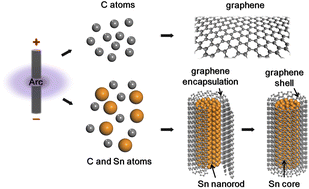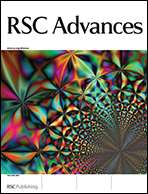Robust and stable intercalated graphene encapsulation of tin nanorods for enhanced cycle and capacity performance for lithium storage†
Abstract
Anode materials (Si, Ge, Sn, etc.) in lithium-ion batteries suffer from a remarkable loss of capacity during the charge–discharge cycle, and various carbon-based additions have been widely added to address this issue. In this work, we report on a simple, one-step approach for an intercalated graphene encapsulation of tin nanorods fabricated via the arc-discharge method. Our method is fast, robust, straight-forward and completely catalyst-free. The result is a Sn@G nanocomposite comprising of a single-crystalline Sn nanorod core tightly bonded to a highly-crystalline graphene shell. The as-synthesized Sn@G exhibits superior cycling and rate performance compared to Sn@C nanocomposite: a reversible specific capacity of 846 mA h g−1 after 100 cycles at the current density of 200 mA g−1 and a reversible rate capacity of 488 mA h g−1 at 2 C for Sn@G, in contrast to the 130 mA h g−1 and 48 mA h g−1, respectively for Sn@C. Further, the Sn@G possesses excellent thermal and chemical stabilities against a 950 °C N2 annealing and a 12 h etching in hydrochloric acid, respectively, and has a high mechanical strength as evident by the intercalated core–shell structure maintaining its shape intact in resisting the volume expansion during the 950 °C annealing. These encouraging results indicate that an in situ graphene encapsulated tin rods nanocomposite constitutes a highly feasible candidate for use as an anode material.


 Please wait while we load your content...
Please wait while we load your content...